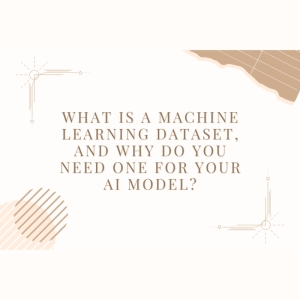What Is a Machine Learning Dataset, and Why Do You Need One for Your AI Model?Posted by Atul on August 25th, 2023  Introduction To Machine Learning DatasetWelcome to the world of machine learning! If you’re here, you’re looking to create an AI model or take advantage of existing ones. One of the first steps in this process is understanding the importance of datasets. In this blog post, we'll discuss what a machine learning dataset is and why it's essential for constructing an AI model. A machine learning dataset is the data used to train a machine learning algorithm. It usually contains both input and output attributes, making it easier for the algorithm to accurately identify patterns in data points. For example, a dataset may contain customer information such as age, income level, location, favorite hobbies and purchase history—all useful pieces of intel for developing marketing strategies or targeting promotions. The purpose of a dataset is twofold: first, it serves as raw material for developing an AI model. The data points are what your machine learning algorithms use to ‘learn’ about how they should behave in different scenarios. Second, datasets are used for validating models; testing them on newly collected data can provide feedback on their accuracy and performance. This feedback helps identify areas where improvement or further training is necessary. Data collection is one of the most important parts of creating a successful dataset; after all, the quality and quantity of data will largely determine how well your AI model performs. Data collection requires research and careful selection in order to make sure that only accurate information is being collected and that all potential features are taken into account when creating your dataset. Machine Learning Data SetsHowever, before you can begin training your model with a data set, it's important to prepare and clean the data. This ensures all of the values are parsed correctly into their proper variables. In addition, feature engineering needs to be done in order to take the raw values from the dataset and use them effectively in your model. Feature engineering basically allows you to expand what is contained within the dataset by creating new features based on existing information or combining multiple features together in one variable. Your dataset will also need labelings depending on whether you're performing supervised or unsupervised learning. Labeled datasets are used when doing supervised learning, which is an ML technique where the AI learns under human guidance. Unlabeled datasets are used for unsupervised learning, which is where the AI deliberately predicts patterns from input data without being told what characteristics should define it. To sum up, a Machine Learning dataset is an essential part of developing an AI model that uses ML techniques like supervised or unsupervised learning. Before using a dataset for ML projects, however, it’s absolutely necessary to prepare and clean it as well as perform feature engineering so that all of its contents can be used effectively by your AI model. Types of ML DatasetsA ML dataset is simply input data that enables an ML model to learn from and make predictions about. Datasets can be gathered from sources like surveys, experiments, or web scraping tools and are often labeled with tags and categories so the ML model can understand the data. Basically, the dataset allows the ML model to “learn” by recognizing patterns or correlations in the data that allow it to make predictions about future events or unknown information. To produce accurate results, it’s important that your dataset be complete and varied. If you have too few or too many data points, the ML model won’t be able to accurately predict outcomes because there isn't enough information to draw a correlation from. Additionally, if all your data points are similar then again there is not sufficient variation in order to create an accurate prediction. Quality datasets must also have timely information – stale information that hasn’t been updated will lead to skewed results due to changes in trends over time. All in all, datasets are just as essential as any other part of constructing an AI model – without them the ML model has nothing to learn from so investing time into collecting quality datasets is key for success. A well crafted set of data points provides all the insight needed for an AI model to make sound predictions within its field of play, allowing you to gain valuable insights with confidence! Why Do You Need an ML Dataset for Your AI Model?First, let’s look at what an ML dataset is. It consists of labeled data that is used to teach machine learning algorithms—usually in supervised learning environments. The labels are important because they help the algorithm recognize patterns in data and learn how to correctly classify them for future predictions. In other words, without labeled datasets, the AI model can’t be trained on the right data and won’t be able to make accurate predictions or decisions. The quality of the dataset used directly affects the accuracy of your AI model’s predictions, as well as its overall performance. If a certain AI feature has poor accuracy or points of failure, it could be because of insufficient training data or errors in labeling. This is why you need a high quality dataset when creating an AI model: it gives your algorithm more information and insights needed to train it properly and gain a comprehensive understanding of its purpose. Overall, by using an ML dataset for your AI model, you are providing it with enough input and knowledge in order to help it learn complex information that will help improve its accuracy and performance levels. So even if you have an idea for an amazing AI project, make sure you include having a high quality dataset if not already present so that your project can truly thrive! Best Data Analytics Courses In India Ways to Acquire a Machine Learning DatasetTo create an effective AI model, you need to get your hands on enough quality data to train it properly. Acquiring such a dataset can be done in several ways: 1. Public Datasets: If you’re looking for existing datasets to use, there are plenty of open source public datasets out there for machine learning tasks. Many of these datasets have already been labeled and divided into training and test sets, so you may not need to do too much preprocessing before using them. 2. Web Scraping: If you’re unable to find suitable datasets in the public domain, web scraping can be another option. With web scraping tools like Octoparse or ParseHub, you can extract large volumes of structured data from websites automatically in a relatively short amount of time. 3. Synthetic Data Generation: In some cases—like when real world data isn’t available—it may be necessary to generate synthetic data instead using AI algorithms and simulation software like Unreal Engine or Unity 3D for developing virtual environments for training purposes). 4. Data Augmentation: Data augmentation is another way to create more training material out of existing datasets by performing various transformations on images (e.g., flipping them horizontally or vertically) or generating artificial speech samples. Best Data Science Institute In India Cleaning and Preparing ML DatasetsThe first step when creating a machine learning dataset is data collection. This involves gathering all relevant information related to the problem you want to solve with your AI model and adding it to one place. Depending on the task, this could involve collecting data from sources such as images, audio recordings, text documents, and sensor readings. Once everything has been collected, the next step is cleaning the data. This involves removing any irrelevant or erroneous information that could affect your model’s effectiveness. The third step in preparing your machine learning dataset is determining which variables are most relevant for your problem. In supervised learning scenarios, identifying what's called the target variable (the variable you want to predict) is key for training your model properly. The remaining variables are then known as features or predictors; these are used by the model to make predictions. After selecting these features, duplicate data should be removed as it can adversely affect accuracy and performance if left in the dataset. The fifth step in preparing a machine learning dataset is normalizing and standardizing the data so that all variables have similar ranges and scales of measurement. This helps reduce bias during training and ensures consistent results throughout hyperparameter tuning processes. Another important task at this stage is outlier detection and removal – any instances in the data which are too far away from other values may not be useful for training purposes or lead to inaccuracies down the line when making predictions with your model. Pitfalls Of Using an Inappropriate or Poor Quality ML DatasetInaccurate data is a potential problem with any dataset. This could be due to measurement or collection errors, outdated facts, or other points of inaccuracy that have crept into the dataset over time. Poorly labeled datasets can also cause problems if labels are inaccurate or outdated, accuracy in predictions will suffer. Unrepresentative sampling is another issue and can be caused by only selecting certain data points from the available pool of information. Insufficient or unsuitable amounts of data can also lead to problems having too little (or too much) data in the dataset means that important details may be missed out or become diluted. Unbalanced datasets (imbalance class distribution) is another common issue that happens when there are unequal numbers of categories being represented in the dataset. Corrupted or missing values in a large amount of ML datasets can prevent AI models from learning effectively as some pieces of information have been removed from the picture entirely. High Quality features often determine good results when using an ML model; low quality features could result in poorer outcomes as they provide insufficient information to drive accurate understanding by machine learning algorithms. Outliers can also lead to issues as they can provide additional noise into AI models leading to lower accuracy with predictions being made by themendly inaccurate results.
Like it? Share it!More by this author |


